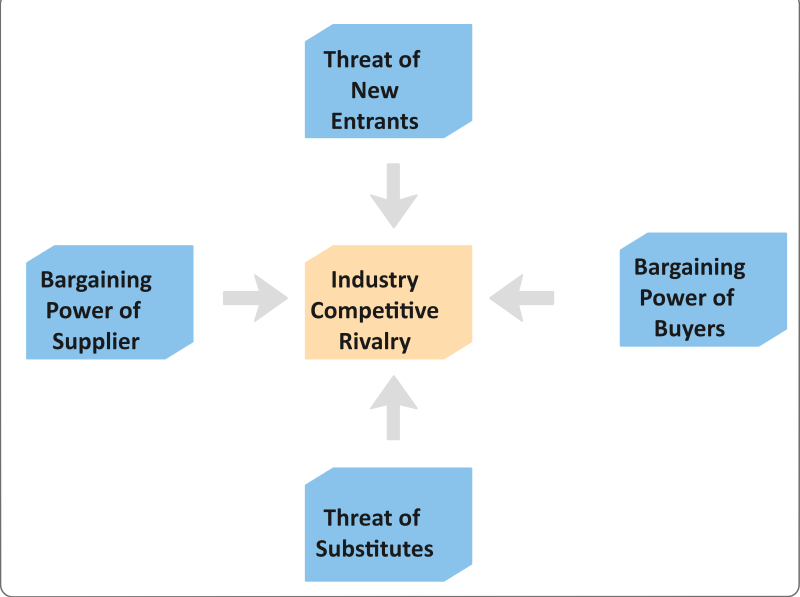Amazon Porter's Five Forces Analysis

1. Introduction
Porter's five forces model is an analysis tool that explains the competition and profit margin in the industry using five forces. These five forces determine the level of competition in that industry using factors like barriers to enter, buyers' and suppliers' bargaining power, substitute products, and so on. Amazon is a leading eCommerce business so let us analyze Amazon Porter's five forces to see how it is doing in the industry.
2. Background of amazon
Amazon was founded in 1994, it was initially a bookstore, but later it diversified itself into a complete eCommerce and cloud computing business. Amazon deals with a very large range of products, including books, electronics, computers, garments, food, toys, furniture, etc. It also produces personal electronics like Kindle, smartphones, and tablets. The services section of Amazon's business deals with cloud services. With this background, let us review Amazon porter's five forces to analyze the forces acting upon them.
3. Amazon Porter's Five Forces
Amazon is the giant and a market leader in the e-commerce industry. But its position is always in danger because of the intense competition; hence, Amazon works hard to maintain its brand image. It especially focuses on the customer experience and making its products and services more user-friendly. So, let us analyze Amazon Porter's five forces model to see how the industry affects Amazon and how it deals with it.
- Competition in the industry (Strong force)
- The threat of new entrants (weak force)
- The bargaining power of suppliers(moderate force)
- The bargaining power of customers(Strong force)
- Threat of substitute products or services(Weak Force)
3.1. Competition in the industry (Strong force)
Amazon operates in a very competitive market, and the Amazon competitors' analysis shows that the rivalry in the online retail market is increasing very rapidly. The number of players in the market is increasing, and small-scale brands and startups are making their place because of low switching costs. Amazon faces throat-cut competition from Walmart, Flipkart, Alibaba, eBay, etc. However, Amazon enjoys economies of scale and large investment options.
3.2. The threat of new entrants (weak force)
Amazon is a giant in the market, and it has a very strong brand image. Also, it enjoys economies of scale and large warehousing and delivery facilities. Since it is a large-scale company, it has a massive investment in eCommerce solutions, customer services, logistics, and marketing. So, it is rather challenging for any company to beat this brand image and make its prominent place in the market. However, small-scale companies can grab a limited segment of customers because of low switching costs. So Amazon Porter's five forces analysis shows that the threat of new entrants is a weak force with no substantial setback for Amazon.
3.3. The bargaining power of suppliers(moderate force)
Suppliers control the availability of products for the eCommerce operations of Amazon. Also, Amazon relies on the equipment and hardware components for information systems in cloud services. In Amazon Porter's five forces analysis, the bargaining power of suppliers is a moderate force. The contributing factors to this force are small suppliers, moderate forward integration, and the size of suppliers.
However, Amazon dictates the supply chain because of its large business and ease of switching suppliers.
3.4. The bargaining power of customers(Strong force)
The bargaining power of buyers in Amazon Porter's five forces model is medium to high. Amazon's success is based on customer satisfaction and product quality. Though switching costs for the customers are very low, substitutes have emerged in large numbers. Customers have access to general information about products and services that different suppliers offer, making it easy for them to find alternatives.
3.5. Threat of substitute products or services(Weak Force)
Amazon Porter's Five Forces Analysis shows some forces in the threat of substitute products and services. These forces are low switching costs, high availability of substitutes, and low cost of substitutes. The low switching costs mean customers can easily choose a customer without any extra cost. So, if they buy from Walmart or Amazon, they do not pay any extra cost. Then many low-scale substitutes offer low-cost substitutes. So, Amazon is continuously fighting against these substitutes to maintain its leadership image. But Amazon's brand image is a successful shield against these threats. Also, its infrastructure, distribution, warehousing network, and service quality are hard to beat.

4. Strategies for Success
After Amazon Porter's five forces analysis, we can now see the success strategies that Amazon employees use to maximize its profits and maintain its brand image. The strategies for success we have identified are cost leadership, differentiation, and focus.
- Cost leadership
- Differentiation
- Focus
4.1. Cost leadership
Amazon's most successful business strategy is cost leadership, and it gains a competitive advantage through price, convenience, and range. Since the profit margins are very less, Amazon counts on its widespread distribution network, warehousing, economies of scale, and a wide customer base. All these factors help Amazon to procure products on higher profit margins.
In the future, Amazon can also increase its customers and sales using the cost leadership strategy, and it can offer more deals and sales to attract buyers.
4.2. Differentiation
Amazon has built its brand on the successful strategy of differentiation. It differentiates itself using cutting-edge technology, human resources, easy-to-use websites, and cloud services. Amazon has software support and algorithms for swift delivery, warehousing, product listings, and so on. Amazon's services business in itself is a pioneer in cloud storage products. Also, electronics and gadgets production can benefit from more advanced products and features.
4.3. Focus
Amazon has many business tracks, including a retail eCommerce store, a cloud services business, and an electronics gadget production track. Focus strategy means focusing on a narrow and specific segment in the market. Amazon can reap the benefits of focus by developing products for geographical locations, the elderly, children, etc.
5. Key Takeaways
Amazon Porter's five forces analysis shows that this company has a strong force of competitors and bargaining power of customers because of low switching costs and high availability of substitutes. The other weak to moderate forces acting on Amazon are suppliers' bargaining power, the threat of new entrants, and the threat of substitutes.
A comprehensive drawing software like EdrawMax allows you to create Amazon Porter's five forces analysis to see all the contributing factors clearly in one glance. You can also create other business diagrams like PERT charts, BCG diagrams, timelines, and business plans using the well-stocked library of templates. Find more Porter’s Five Forces templates.
6. References
-
Rutakirwa, Tonny. 2018. ANALYSIS OF AMAZON. MANAGEMENT AND ORGANISATIONS.











